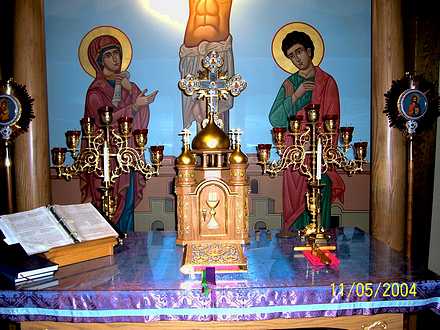The central spot within an Orthodox Church is the Holy Altar, for it is the table upon which the bread and wine are changed into the Body and Blood of Christ. The symbols carved into the base are a sprig of wheat which surrounds a grape vine, symbols of the Eucharist, and a dove which symbolizes the Holy Spirit. A relic (bone) of a martyr is always kept upon the altar, sewed into a cloth, as a reminder that the Church grew from the sacrifices of these courageous people. It was the custom of the early Christians to celebrate the Liturgy over the graves of the martyrs on the anniversaries of their deaths. We continue this practice at every Liturgy.
Articles on the Altar
Placed in the center of the altar is the Tabernacle in which is kept the Eucharist for the sick. In the Old Testament, the tablets of the Law, the Ten Commandments, were kept in the Tabernacle. (1 Kings 8:9) In the New Testament, it is the Lord Himself who dwells here. The altar then becomes the throne of God on earth, and the church is truly a house of God by Christ’s presence in the Eucharist. This is why Orthodox Christians should make the sign of the Cross whenever they pass the Holy Altar.
In front of the Tabernacle is the book of the Holy Gospels which is decorated with icons and precious stones. This shows the honor that we give to the Scriptures as the word of God. Christ is present on the altar as the Word of Life in the Gospel Book, and as the Bread of Life in the Tabernacle.
The Baldalchin
The baldalchin, the canopy above the altar, denotes that this is a holy place. It also reminds us of the heavens above which God has “stretched out like a canopy” (Psalm 104). Since the floor below symbolizes the earth, and the baldalchin symbolizes heaven, the altar raised between the two becomes a meeting place of heaven and earth. This occurs when bread and wine, material things, becomes the Body and Blood of Christ, spiritual things.

